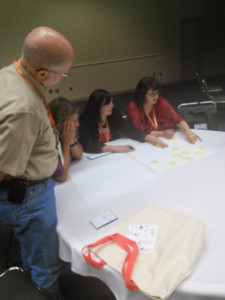Have you ever been in a meeting or planning session that goes something like this – we want to change x, let’s do y and z and that will lead to x…? Have you found that y and z are frequently the same y and z that your organisation always does, whether that is high level lobbying, a petition, or community-based organising?
Participants at our recent theory of change training at Netroots Nation in Detroit told us that the most interesting, useful and maybe even confronting thing about trying to use theory of change is that you can realise how limited your strategising about change has been in the past.

At our Netroots training, four generous participants shared their current campaigns as the basis for a theory of change exercise with fellow conference goers. The groups worked to develop theories of change for achieving efficient and accessible public transport in Detroit (after being there we can tell you the city needs it!), enabling access to fair re-servicing of all student loans in the US, achieving a sustainable union movement in Michigan, and all pregnant women in the US being protected from discrimination.
For each of these, the groups determined a long term outcome and then worked back through the outcomes that would need to be in place to achieve the long term goal, and their relationships to each other.
What participants found, and what we often find is that our natural defaults are to think about activities rather than outcomes – people were putting things down like “engage young people” or “get media”. But, of course, these aren’t outcomes and don’t tell us about what needs to be in place to achieve change – they tell us more about what we are used to doing or assume works. The beauty of the theory of change approach is that it helps you step back and look more broadly at what is needed, before you then ask what can we do to contribute within this. What that can reveal are distinct pathways of change, and your role within a much bigger network of actors.
Ideally you would create a theory of change with people with a stake in the issue and after doing preparation through research and analysis. Still, participants fed back to us that this helped challenge how they normally think about change – and helped reveal how limited our strategising is when we work from what we’ll do to what we think will happen in the world. That kind of thinking puts us at the center, often just replicates the tactics we’ve used before and doesn’t help us see new potential pathways or the contributions of other groups or actors. As one participant shared: “this was harder than I thought and yet so crucial to really think about what is needed”.
You can read more about theory of change methods through the resources provided by our friends at the Center for Theory of Change (http://theoryofchange.org/). Our recent report analysing dominant theories of change for engaging people on global issues is still available at corelab.co/theoriesofchange. If you’d like to talk about how to use this method and what it can do for your campaign, you can always get in touch – hello@corelab.co.
First published at http://ideas.corelab.co/if-x-then-y-or-maybe-not/
